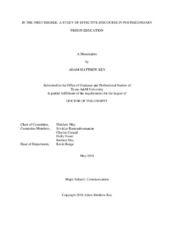| dc.description.abstract | Numerous studies, on both micro and macro levels, confirm that providing postsecondary education to prisoners works to reduce the rate of recidivism. Understanding that the phenomenon is works, however, does not answer the question as to why prison education is effective. Two of every three prisoners begin their incarceration without a high school diploma. Despite the majority of prisoners departing from the K-12 education system before completion through expulsion, dropping out, or failing grades, large numbers of prisoners are able to succeed in college classes. I argue that the answer lies within the communication practices occurring within prison classrooms that allow students to be discursively produced as scholars, rather than deviants. Using the method of participatory critical rhetoric, I analyzed prison classroom communication through three distinct, yet related lenses: ethnography, rhetoric, and media.
The ethnographic analysis revealed their K-12 teachers, adhering to the norms of the education system, communicated apathy and a demand for adherence to values that were not own. In prison classrooms, however, their teachers communicated that their voice and opinion had value, gave them space to communicate freely, and kept them engaged and excited. Critical rhetorical analysis to the interviews demonstrated two primary discourses circulating through prison classrooms: a discourse of individuality and a discourse of care. The fusion of these discourses allowed for a fissure into the organizational rhetoric of the prison system, allowing both students and instructors to enact a rhetoric of love. In media analysis, I explored dominant discourses about prisoners circulating through popular media and news reports. Using cultivation theory and social learning theory, I argued that the general public is taught a bias against prisoners in much the same way as they are biased against minorities. I discussed how the bureaucratic system, by prohibiting positive portrayals of prisoners, insulates itself against public scrutiny and allows the bias and its effects to continue unabated. | en |


